 The CDC says we should stay at least six feet apart, but baby, my lips can't reach that far. 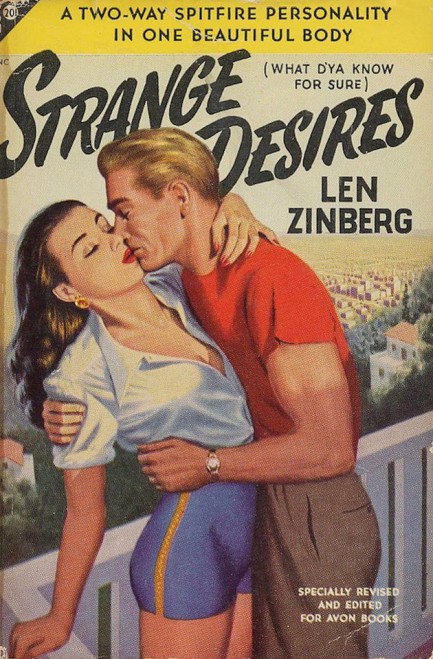
CDC, our many non-U.S. readers may need to know, stands for the Centers for Disease Control, and while maybe it's not in the best taste to kid about coronavirus, when did taste ever matter us? There's virus rampant where we live, but luckily we don't have to leave our place, which is the benefit of having weeks of food in the larder and your entire work life online. Our last foray outside was for PSGP's birthday party last Saturday, for which we made lots of hand sanitizer out of aloe gel, anti-microbial lavender oil, and vodka. These props were intended as a little joke, but our ulterior motive was to remind everyone to take the precautions recommended by health authorities. We predicted that night would be the last hurrah around here for a while and we were right, as now schools, sporting events, and other gatherings of people have been restricted. We're glad we had one last get-together before those changes came, and so far—fingers crossed—all fifty or so people that showed up seem to be fine.
Other people who are getting in a last get-together are the couple on this cover of Len Zinberg's Strange Desires, originally published in 1946 as What D'ya Know for Sure. This great piece was painted for Avon's 1949 edition by Ann Cantor, who we've featured several times, including on Maurice Leblanc's Wanton Venus, one of our personal favorites. Zinberg was the real name of prolific U.S. author Ed Lacy, whose boxing opus Go for the Body we just talked about last week. No boxing in this one, unless clinches count. This is about Hollywood, making movies, industry ambition, redemption for the damaged, and those sorts of things. Just like in Go for the Body the narrative makes a surprising turn near the end, and just like in The Woman Aroused, the story hinges on a disturbed femme fatale. Like we said‚ Zinberg/Lacy was prolific, which we guess means he borrowed from himself occasionally. We should know—we've been borrowing from ourselves here for twelve years. More Zinberg/Lacy coming soon.
 Oh, I plan to go for his body, alright. Particularly below the belt. I hope he plans the same for mine. 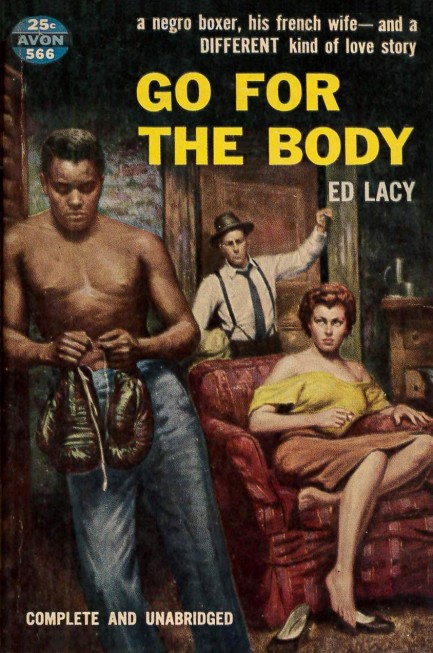
Ed Lacy is a fascinating writer, a fearless conceptualizer who sought unique angles for his vivid, often racially charged tales. His 1954 novel Go for the Body is a story of amazing imagination dealing with an ex-boxer and would-be promotor named Ken Francine who runs across a black American boxer in Paris. Francine already knows this other boxer, Bud Stewart, from Stateside. In fact, Stewart was the reason Francine retired, a decision brought on by a brutal ass-whipping that exposed his deficiencies in the ring. Now, years later in Paris, Francine sees an opportunity for profit, and begins pushing Stewart up the ladder in the European fight racket. The text on the cover art is deceptive. The book isn't really about the love story, “DIFFERENT” or otherwise, between Stewart and his beautiful wife. It's about Francine, local politics, the dirty work of promoting boxers, and murder.
In the hands of a brilliant writer this could have been an all-time classic. Don't get us wrong—it's still enjoyable. Lacy evokes the atmosphere of Paris effortlessly by sharing minute details. He never crosses the line into travelogue. A quip about the trendiness and expense of Perrier followed by a local's aside that the pipes in European cities weren't always great is enough to plant the idea in the reader's head that fizzy bottled water became popular because it was known to be clean. Another example is how Lacy doesn't bother to describe any of the geography or people of Champs-Élysées, but simply notes that you see big American cars there. He makes clever choices like these throughout Go for the Body, never taking the obvious route, instead relying on readers' ingrained knowledge of Paris from popular culture to fill in the blanks.
His plot does the same. Guessing which direction the narrative will go will likely prove fruitless. Of course, certain aspects are required, such as the Parisian flavor, the post-war malaise, and the nostalgia for a lost love. And naturally, boxing novels nearly always lead up to a big fight, and this one does too, in Milan, Italy. But there's far more on the line in that final bout than any reader could possibly suspect when the book begins. That's the main reason we give Go for the Body a thumbs up—its scope. Lacy is no Faulkner or Malamud, and his main character Ken Francine is confoundingly slow-witted at times (as an ex-fighter who was literally beaten into retirement it's possible he's not supposed to be very bright), but the tale delivers a solid punch. It may not knock you for a loop, but in the end the decision goes in its favor.
 That was a real interesting story. I bet the cops would've loved to hear it. 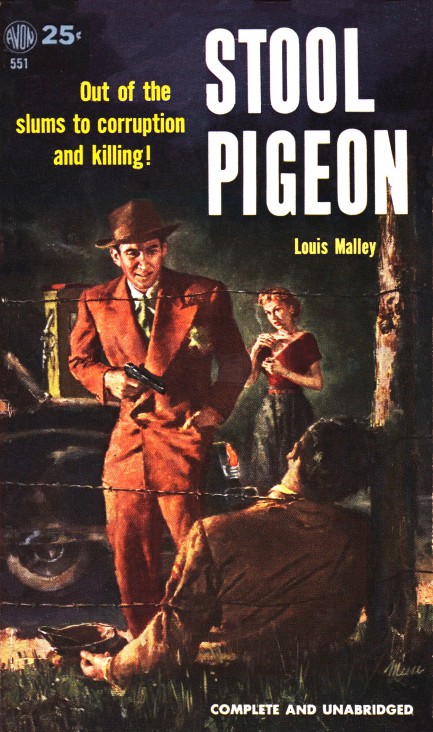
Louis Malley's 1953 cop thriller Stool Pigeon might better be called “Stool Pigeons,” because it's about how crime solving hinges on a network of informants, and how reliable snitches make average detectives great. All the detectives in the book have their own, and they're sometimes kept so secret that nobody else on the police force knows who they are. If an informant's identity ever gets out they usually go from stool pigeon to cooked goose, as shown in the cover scene painted by James Meese. As we read this book we kept expecting one of the multiple stool pigeons to emerge as pivotal, and that's exactly what happens. We won't tell you which one proves most important, but we will say Malley takes a fresh angle on the typical cop novel and does it reasonably well.
 I'd prefer to eat her with a Château Latour Pauillac and some grilled vegetables, but a werewolf has to make do. 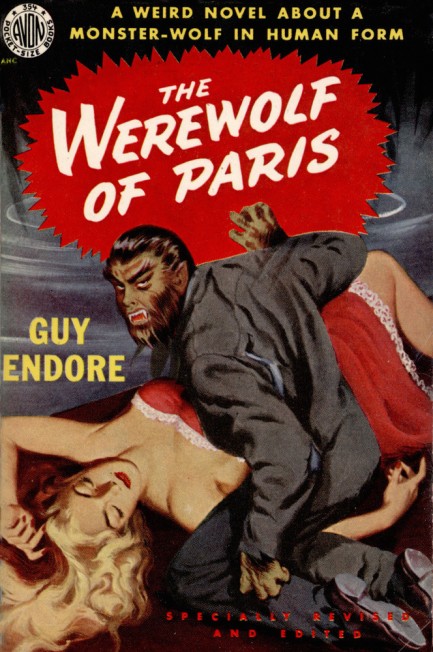
This lycanthrope painted by William Randolph for the cover of Avon's 1951 edition of Guy Endore's The Werewolf of Paris has been caught red-handed eating his entree without a side and a garnish, not to mention the lack of a fine red wine. Being a murderous werewolf is one thing. That can be forgiven. But eating this way could cost him his French citizenship. Endore's take on werewolfery was originally published in 1933, was almost forgotten as recently as a few years ago, but seems to be gaining stature of late. We're happy to do our part. It's a deliberate tale—its setting in late 1800s France first has to be framed by a 1930s snoop doing a retelling from a found court manuscript, then within the account the wolfman character of Bertrand must be conceived, born, and raised, before being set on his bloody path in Paris, a city that offers a perfect hiding place. Endore explains why with this lyrical passage:
Before the greater importance of thousands going to death, before a greater werewolf drinking the blood of regiments, of what importance was a little werewolf like Bertrand?
Which is to say Bertrand has disappeared into the labyrinth of Paris during the chaos of the Franco-Prussian War. His appetites soon grow to include not only the living, but the dead, which he digs from fresh graves in Père Lachaise and Cimetière de Montmartre. Pretty interesting stuff, this novel. Of course, werewolf stories always end tragically, but it's the journey that matters. Endore crafts an atmospheric tale—and one that's frank too, for 1933. Endore counts on his readers to not be puritannical about Bertrand's sexual explorations. Nor about sacrilege, nor children being eaten, nor incest, it seems. But as horrific as all these atrocities are, ultimately Endore asks which is the greater werewolf—Bertrand or war? Since in reality one exists and the other doesn't, we know the answer. The Werewolf of Paris is a fascinating tale, not pulp style, but certainly worth a read for fans of any types of fiction. 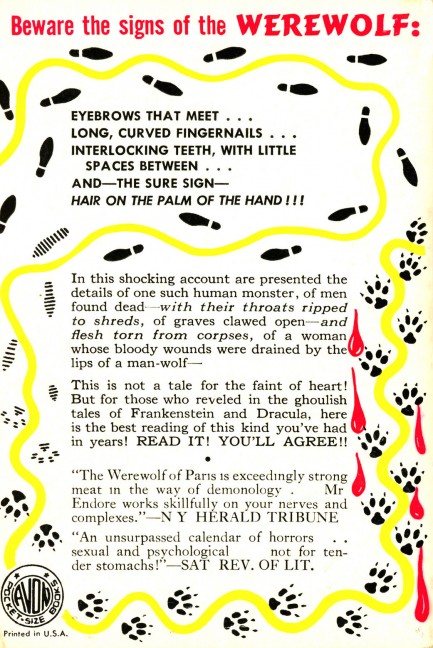
 In my experience the ones who think I'm sinful are always the ones I won't let join the fun. 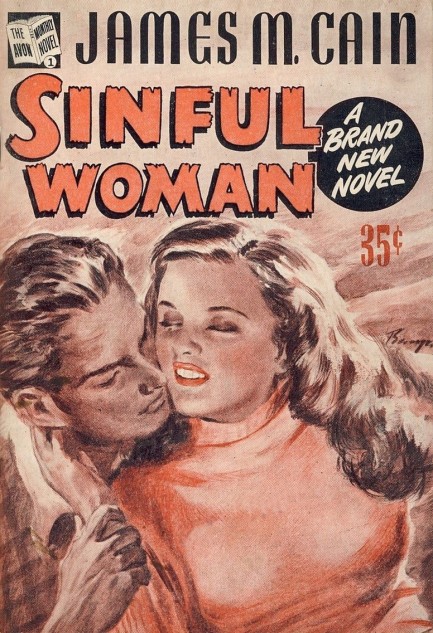
Above is a brilliant cover for James M. Cain's Sinful Woman painted by Barye Phillips, early work from him, and among his best. This was published by Avon in 1947, and though it isn't hard to find it's dear to purchase. The story involves a famous actress who goes to Reno for a quickie divorce from her movie producer husband. When she runs into problems she charms the local sheriff—a big fan of her work—into helping out, but must deal with increasing complications. Most agree Sinful Woman isn't Cain's best, but from a purely literary perspective he's a better writer than most, even in lesser efforts. It's well worth a read.
 Biggers isn't always better but he tried. 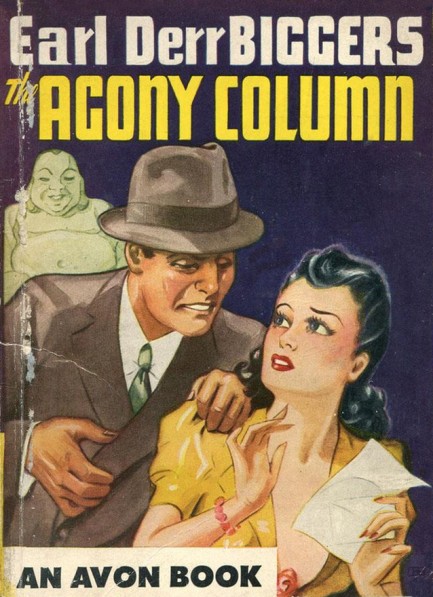
What's an agony column? Basically it's a newspaper feature in which readers writes messages to other readers. For example: “Regular at Main Street Cafe who takes her coffee every weekday morning just before 9:00. Would you be amenable to meeting a certain gentleman who has admired you from afar?” You get the idea. The “agony” in the terminology derives from the fact that people who write in generally are suffering from some sort of heartache or other.
The Agony Column is basically an epistolary mystery, in which a man writes letters to the crush he contacted through a London newspaper's agony column, and details his involvement in a puzzling murder case. It's a very esoteric set-up for a novel, and besides mystery there's a dose of cute romance. Nearly the entire book takes the form of the main character's letters, though some sections are conventionally written.
The nature of the novel requires more suspension of disbelief than usual, simply because nobody really writes letters with detailed, multi-character dialogue, but once you get over that hurdle it works pretty well. There are other hurdles. About London's Chinatown the main character writes, “Not only the heathen Chinee so peculiar shuffle through its dim-lit alleys, but the scum of the earth of many colors and of many climes. The Arab and the Hindu, the Malayan and the Jap, black men from the Congo and fair men from Scandinavia.”
Ouch. That brought the cuteness to a screeching halt. But readers should note that Biggers evolved, and would later create the Chinese American detective Charlie Chan partly as a counter to racist portrayals of Asians. The books were popular, but as the decades progressed people soured on them because Chan too is a racial stereotype. It's difficult for authors to write characters—especially outside their own ethnic group—that stand up over time as social mores change. But they keep trying, and should, in our opinion. What would fiction be like if they didn't?
The Agony Column has plenty of positives. Being set on the eve of World War I in a London gripped by tension over the looming global hostilities lends it atmosphere, and the mystery itself contains a few surprises we doubt most readers will foresee. It's also a short tale, which keeps the epistolary gimmick from wearing thin. We think it's worth a read. The Agony Column originally appeared in 1916, with this Avon edition, illegibly signed by the cover artist and unattributed inside, coming in 1943.
 Then you die. And she's happy about it. 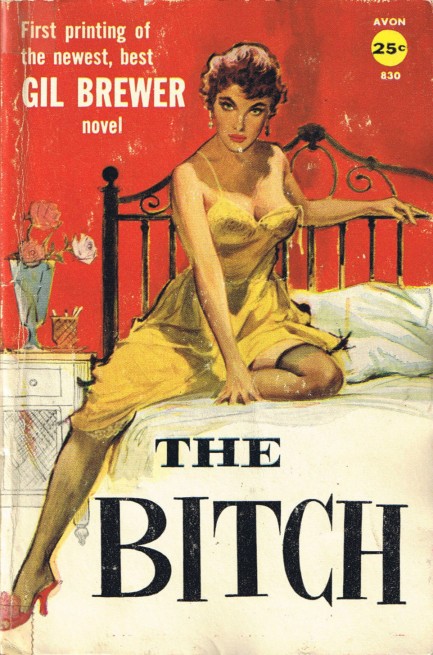
To quote Queen Latifah: “Who you callin' a bitch?” In this 1958 thriller trusty old Gil Brewer concocts a tale in which violent events are unleashed when a detective is hired to shadow a cheating wife. He learns there's two-hundred grand in a safe and stages a robbery, which of course goes spectacularly wrong, and leads to him being identified as the thief. He's suddenly on the run and everyone he knows is chasing after his big bag of money. Treachery abounds. There are actually two wives in this story. Which one is the bitch of the title? Well, from the narrator's point of view, probably both. But his troubles are his own fault. The book is fun, but there's a curiously aimless quality to this particular effort from Brewer. He's done better. The cover art, on the other hand, is about the best you'll see, though it's uncredited. Now we'll let Queen have the last word:
One day I was walking down the block. I had my cutoff shorts on, right, ’cause it was crazy hot. I walked past these dudes. When they passed me one of 'em felt my booty. He was nasty. I turned around red. Somebody was catching the wrath. Then the little one said, “Yeah me, bitch,” and laughed. Since he was with his boys he tried to break fly. I punched him dead in his eye, and said, “Who you callin' a bitch?”
 Help... dying... last wish... to see dripping wet naked woman. 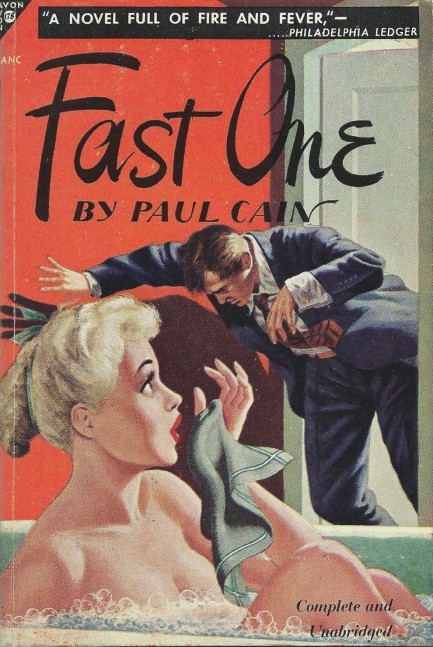
The cover art for this 1948 Avon edition of Paul Cain's Fast One kind of looks like a guy's about to drop dead in front of a bathing woman, but actually he's merely been shoved into the bathroom by the story's anti-hero protagonist. It's always interesting which moment an artist (or a publisher directing an artist) will choose for a cover. This is not an important event in the narrative, but the chance to show a woman in the bath was apparently too enticing to pass up. The backdrop here is prohibition era Los Angeles and the main character Gerry Kells and the femme fatale S (we never learn her first name) are pulled into a maelstrom of trouble when Kells refuses to work for his old crime buddies and in retaliation they frame him for murder. The novel was put together from five stories that appeared in Black Mask magazine, and when it was published Cain—aka Peter Ruric, aka George Sims—was hailed as a giant of hard-boiled fiction on par with Hammett and Chandler. We don't know about that, but Fast One is a good read—bare bones and quick paced and filled with random brutality. The bio page for Fast One says Cain “has lived as he writes—at high speed and with violence.” It's a phrase that makes you want details but none are provided. We imagine the description is accurate, though, because Cain published this single novel, as well as some screenplays (including for The Black Cat), then vanished into obscurity and eventually died of alcoholism.
 What does the cover have to do with the story? Virtually nothing. 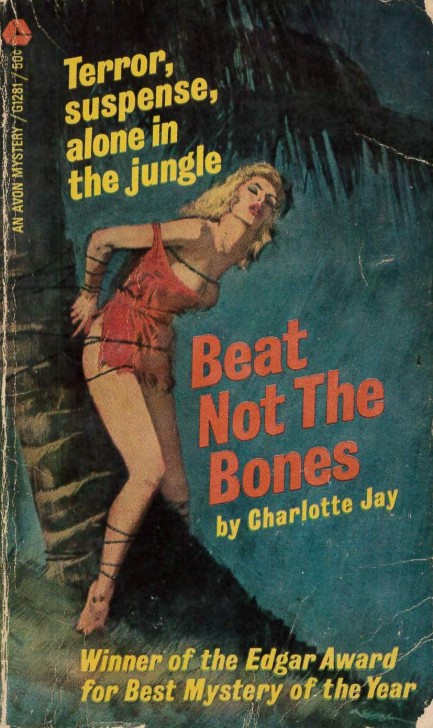
We showed you a 1955 Avon Publications cover for Charlotte Jay's award winning thriller Beat Not the Bones, and above you see an alternate cover from Avon that came in 1966. We don't remember the main character ever being tied to a tree, and we're sure she certainly never wore the sexy rag you see here, but those are the vagaries of good girl art. Both the 1955 cover and this one depict scenes that didn't happen in the story, but the earlier version is a but more true to the spirit of Jay's tale, where the above goes for pure titillation. We love them both. This one is by the always excellent Ron Lesser, and his original painting appears below.
 Two publishing houses take turns spicing up a classic. 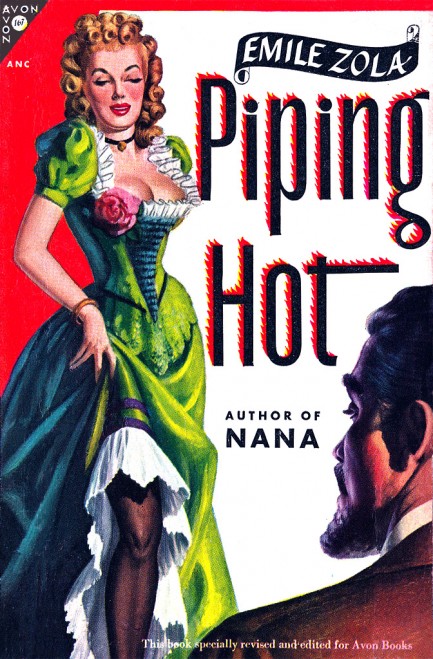
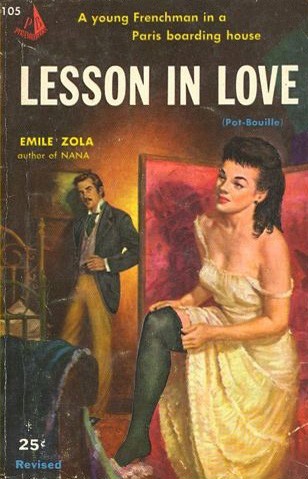 We’ve mentioned a few times how classic literature often got the pulp treatment, and today we have a prime example. Emile Zola’s 1887 novel Pot-bouille was a satire of the French bourgeoisie, and in style it was probably not the sort of thing an average pulp reader would have appreciated. But more than a few of them must have been drawn to Avon’s 1948 version, re-titled Piping Hot and paired with eye-catching art by Ann Cantor. The book also got a pulp treatment from Pyramid in 1953 when they re-titled it Lesson in Love and copied Cantor’s petticoat and exposed leg theme but moved it to the boudoir. We don’t know who painted that cover, but if you want to see a couple more pieces from Cantor, try here. We’ve mentioned a few times how classic literature often got the pulp treatment, and today we have a prime example. Emile Zola’s 1887 novel Pot-bouille was a satire of the French bourgeoisie, and in style it was probably not the sort of thing an average pulp reader would have appreciated. But more than a few of them must have been drawn to Avon’s 1948 version, re-titled Piping Hot and paired with eye-catching art by Ann Cantor. The book also got a pulp treatment from Pyramid in 1953 when they re-titled it Lesson in Love and copied Cantor’s petticoat and exposed leg theme but moved it to the boudoir. We don’t know who painted that cover, but if you want to see a couple more pieces from Cantor, try here.
|
 |

The headlines that mattered yesteryear.
1923—Yankee Stadium Opens
In New York City, Yankee Stadium, home of Major League Baseball's New York Yankees, opens with the Yankees beating their eternal rivals the Boston Red Sox 4 to 1. The stadium, which is nicknamed The House that Ruth Built, sees the Yankees become the most successful franchise in baseball history. It is eventually replaced by a new Yankee Stadium and closes in September 2008. 1961—Bay of Pigs Invasion Is Launched
A group of CIA financed and trained Cuban refugees lands at the Bay of Pigs in southern Cuba with the aim of ousting Fidel Castro. However, the invasion fails badly and the result is embarrassment for U.S. president John F. Kennedy and a major boost in popularity for Fidel Castro, and also has the effect of pushing him toward the Soviet Union for protection. 1943—First LSD Trip Takes Place
Swiss scientist Albert Hofmann, while working at Sandoz Laboratories in Basel, accidentally absorbs lysergic acid diethylamide, better known as LSD, and thus discovers its psychedelic properties. He had first synthesized the substance five years earlier but hadn't been aware of its effects. He goes on to write scores of articles and books about his creation.
|

|
|

It's easy. We have an uploader that makes it a snap. Use it to submit your art, text, header, and subhead. Your post can be funny, serious, or anything in between, as long as it's vintage pulp. You'll get a byline and experience the fleeting pride of free authorship. We'll edit your post for typos, but the rest is up to you. Click here to give us your best shot.

|
|






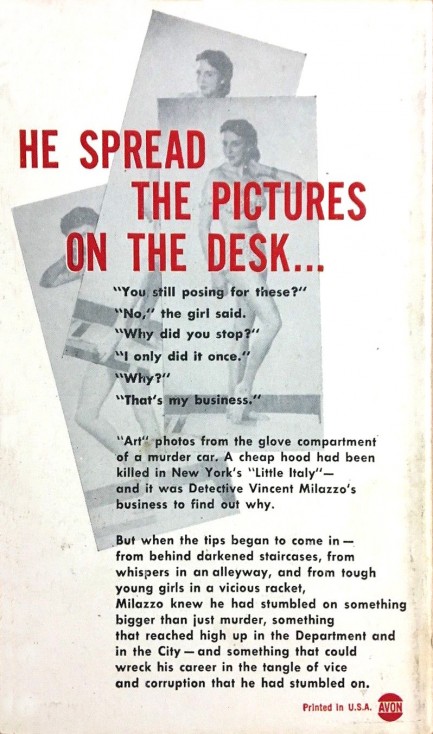













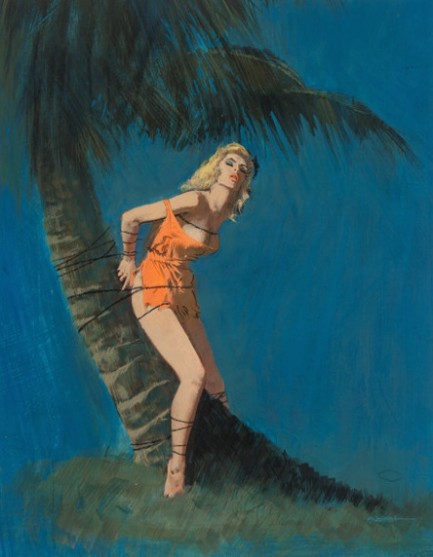


 We’ve mentioned a few times how classic literature often got the pulp treatment, and today we have a prime example. Emile Zola’s 1887 novel Pot-bouille was a satire of the French bourgeoisie, and in style it was probably not the sort of thing an average pulp reader would have appreciated. But more than a few of them must have been drawn to Avon’s 1948 version, re-titled Piping Hot and paired with eye-catching art by Ann Cantor. The book also got a pulp treatment from Pyramid in 1953 when they re-titled it Lesson in Love and copied Cantor’s petticoat and exposed leg theme but moved it to the boudoir. We don’t know who painted that cover, but if you want to see a couple more pieces from Cantor, try here.
We’ve mentioned a few times how classic literature often got the pulp treatment, and today we have a prime example. Emile Zola’s 1887 novel Pot-bouille was a satire of the French bourgeoisie, and in style it was probably not the sort of thing an average pulp reader would have appreciated. But more than a few of them must have been drawn to Avon’s 1948 version, re-titled Piping Hot and paired with eye-catching art by Ann Cantor. The book also got a pulp treatment from Pyramid in 1953 when they re-titled it Lesson in Love and copied Cantor’s petticoat and exposed leg theme but moved it to the boudoir. We don’t know who painted that cover, but if you want to see a couple more pieces from Cantor, try here. 





































































